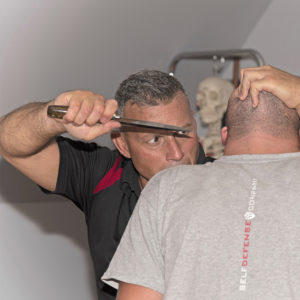“The 10 Warning Signs of Terrorist Activity”
1. Suspicious activity related to fireworks.
Federal authorities have advised local law enforcement to take notice of anyone asking questions about fireworks “that go beyond mere curiosity about the potential damage fireworks could cause.”
Authorities are worried an extremist or lone wolf could repackage the explosives in fireworks as an improvised explosive device. The death of a 47-year-old Michigan man occurred when a large mortar fireworks shell he was holding detonated served as a tragic reminder of just how dangerous fireworks can be.
So if you see someone behaving strangely at your neighborhood fireworks stand — perhaps asking questions suggesting another use in mind beyond casual entertainment — that might be a good time to say something to police.
2. Probing or testing the perimeter of a fence, facility, or its security systems.
Most attacks involve some form of reconnaissance. Sometimes this is as cursory as snapping a few cellphone images for later review and planning. Other perpetrators will devote time to mapping out their routes, even studying the timing of traffic lights and commuter patterns. They may even embark on a rehearsal prior to the actual attack.
If you see someone loitering or behaving in a suspicious way — like checking out an employee-only entrance at a shopping mall, or examining the integrity of a fence along a regional airport — let local law enforcement know that you see something that looks strange. Police receive inquiries like that all the time, and as long as the call is sincere and genuine, they are happy to dispatch a patrol officer to check out the suspicious activity.
3. Anyone setting a backpack or bag down in a crowd and walking away.
This should trigger immediate concern. While the behavior could be completely harmless, it is certainly suspicious and could be a prelude to a devastating attack along the lines of the 2013 Boston Marathon bombing.
In the wake of that incident, authorities have grown more careful about inspecting bags and purses being toted into major events. But security at local venues may be less rigorous. Police say informing them of suspicious unattended bags, briefcases, or luggage could be a real lifesaver.
4. Suspicious use of social media or the Internet.
Federal officials say the Islamic State (ISIS) and other extremist groups are currently engaged on a daily basis in trying to use social media and the Internet to recruit and radicalize disaffected citizens. When police earlier this year got a tip that a young man in Ohio was engaging in suspicious activity on social media, it apparently helped thwart an ISIS-inspired attack on the Capitol. According to government documents, an informant notified the FBI that the suspect, 20-year-old Christopher Lee Cornell of Green Township, Ohio, was using an alias on Twitter accounts to express support for violent jihad.
The FBI says Cornell planned to detonate pipe bombs at the busy Capitol, then open fire on bystanders and responders during the ensuing chaos. Immediately after making that arrest the FBI issued a bulletin to local law enforcement that read: “Terrorist group members and supporters will almost certainly continue to use social media platforms to disseminate English-language violent extremist messages.”
5. Purchases of suspicious supplies.
There can be a fine line between purchasing materials for ordinary use and stockpiling dangerous or suspicious items — explosives, weapons, and ammunition. Actual planning of an attack can involve more subtle purchases: Maps, uniforms, body armor, flight manuals, how-to books, materials needed to make passes or badges, or the equipment used to manufacture identity-related documents. Whether a purchase rises to the level of saying something to law enforcement probably depends on context, and intuition regarding the individual involved.
6. Attempts at impersonation.
It should go without saying that people trying to pass themselves off as someone they’re not are inherently suspicious. Beyond halloween or some harmless role playing… it’s difficult to imagine why any legitimate person would want to look like a law officers, soldier, or company employee when they clearly aren’t.
7. Unusually large or heavy bags.
If someone has difficulty hefting a backpack, that could be unusual. According to SecureTransit.org, a website funded by the Department of Homeland Security, you should be mindful whenever people appear to be commuting with an unusually heavy or large backpack, gym bag, or other luggage. This would especially be a concern if the bag were to be abandoned.
Also suspicious: Any attempt to store a bag in a compartment other than the one the owner is riding in.
8. Unusually bulky, loose-fitting apparel worn in hot weather.
In countries like Israel where security is paramount, officers are trained to spot people whose clothing seems out of place or disproportionate to their body type. Increasingly, that’s a concern U.S. officials are talking about as well, because thick or baggy clothing can be used to conceal weapons.
9. Any sign of tampering.
It might not be a person you need to report, but a situation. Exposed wiring, strange smells, leaks, or any sign of potential tampering, especially on a bus or train, is something you should consider reporting. And authorities definitely want you to let them know if anyone appears to be tampering with safety systems, electronics, surveillance cameras, or other equipment.
10. Suspicious or abandoned vehicles.
Remember New York’s Times Square bombing attempt in May 2010? A street vendor spotted smoke coming from a parked SUV, and alerted the NYPD. It turned out the vehicle contained an improvised pipe bomb, gunpowder, gasoline, and three 20-gallon tanks of propane. Authorities later said the bomb would have caused a massive fireball, intense shrapnel, and many casualties had it gone off.
It can be difficult to know whether a car is simply parked, or has been abandoned. The important thing is to be cognizant of the potential danger, and to let police know immediately if you see something unusual.
One last bit of advice from the experts: Trust your instincts. No one is better equipped than you to know what does or does not belong in your immediate environment. Odds are you’ll sense when something’s just not right.
One Department of Homeland Security video describes the act of “seeing something” this way: “It’s when you experience a moment of uncertainty. Something you know shouldn’t be there. Or someone’s behavior that doesn’t seem quite right. These are the moments to take a pause. Because if something doesn’t feel right, it’s probably not.”
Sources: DHS.gov See-Something-Say-Something Campaign; SecureTransit.org; University of Tennessee at Knoxville UTK.edu “8 Signs of Terrorism.”










